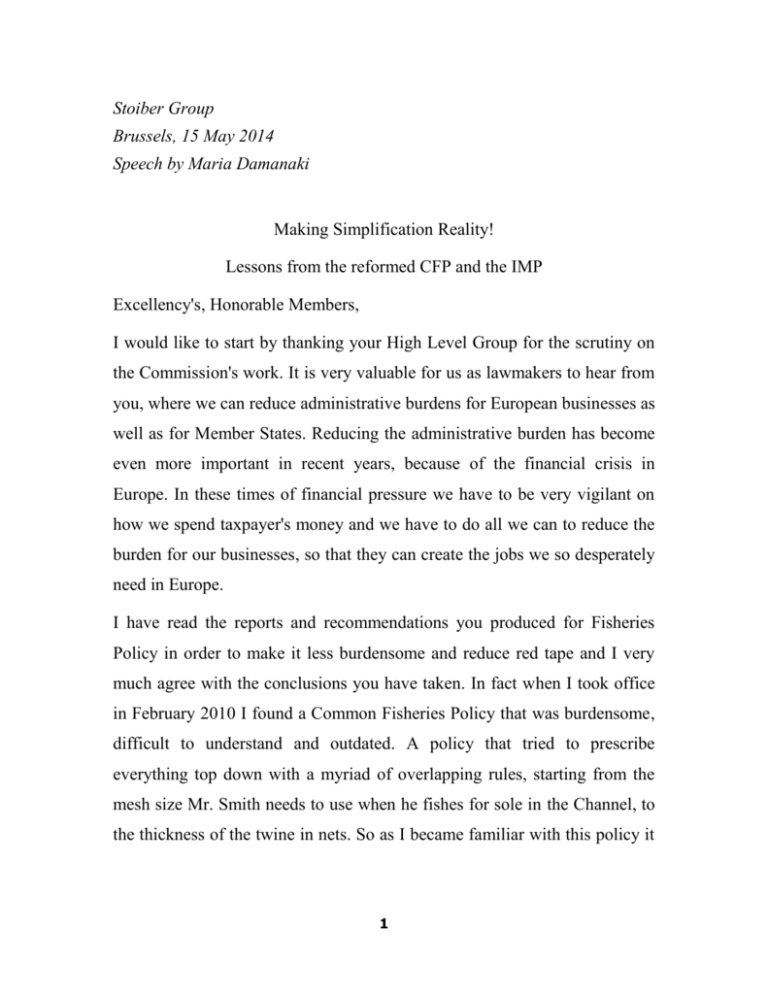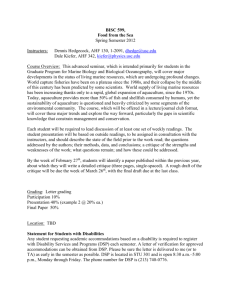Reform in Europe is possible – lessons to be learned from fisheries
advertisement

Stoiber Group Brussels, 15 May 2014 Speech by Maria Damanaki Making Simplification Reality! Lessons from the reformed CFP and the IMP Excellency's, Honorable Members, I would like to start by thanking your High Level Group for the scrutiny on the Commission's work. It is very valuable for us as lawmakers to hear from you, where we can reduce administrative burdens for European businesses as well as for Member States. Reducing the administrative burden has become even more important in recent years, because of the financial crisis in Europe. In these times of financial pressure we have to be very vigilant on how we spend taxpayer's money and we have to do all we can to reduce the burden for our businesses, so that they can create the jobs we so desperately need in Europe. I have read the reports and recommendations you produced for Fisheries Policy in order to make it less burdensome and reduce red tape and I very much agree with the conclusions you have taken. In fact when I took office in February 2010 I found a Common Fisheries Policy that was burdensome, difficult to understand and outdated. A policy that tried to prescribe everything top down with a myriad of overlapping rules, starting from the mesh size Mr. Smith needs to use when he fishes for sole in the Channel, to the thickness of the twine in nets. So as I became familiar with this policy it 1 became clear to me that when we reform the policy we must also make it simpler. But let me first describe how fisheries policy became so complicated. Fish stocks were dwindling every year. So in order to stop this downward spiral we added measure after measure in a patchwork like approach. Obviously that was the wrong approach, because we ended up with layers and layers of regulations that did not achieve the sustainability our maritime regions were in desperate need of. The result was a system of cumbersome and antiquated rules. We detected many things that were not right: overfishing, discarding, top down decisions with no input from stakeholders and no binding rules for international fisheries. With the reform we have tackled these problems – and we have simplified the policy greatly a) to stop overfishing and put an end to discarding, b) to stop the top down decisions and make room for regionalization, c) to have for the first time ever sustainable standards in the international part of pour policy, d) to get rid of bottlenecks for aquaculture businesses, e) to simplify the common market organization for fisheries products and f) to streamline the new maritime and fisheries structural fund. So overfishing, what did we do? The Commission proposes to maximize catches at a sustainable level in the long term – we call this Maximum Sustainable Yield or MSY. Last December, when the reform was not even in 2 force yet, Fisheries Ministers have unanimously agreed fish quotas at a sustainable level. The decision means we have increased more than fivefold the number of healthy fish stocks starting from only 5 in 2009 to 27 healthy stocks in 2014. But there is more good news, because the Parliament and the Council have finally managed to get out of the deadlock on multi annual plans. Thanks to the new agreement we can start tabling such long terms plans again and that is good news for the fishermen, because multi annual planning gives them the clarity they need for their business decisions. Then on discarding. For decades fishermen have been throwing back into the sea fish that was too small… outside permitted quotas… or perfectly allowed, but with low market value. Our reform turns this around too. An obligation to land all catches will gradually cover all European fisheries over a five-year period. One of your questions is asking how the Commission plans to ensure that the administrative burden for businesses because of introducing the landing obligation is minimized? Here I need to point out something that is fundamental and often overlooked. Yes, in the beginning there is a burden on operators, because they have to land the fish they used to throw away. But this is changing, because the Commission is giving financial incentives to fishermen to avoid catching unwanted fish in the first place. The fishermen themselves are already coming up with technical solutions to catch only what they can market. So it is important to see that in the long run there is no additional administrative burden on operators because of the landing obligation. Apart from that you may wonder how sustainable fish quotas and landing all catches simplify the Common Fisheries Policy? Well, they deliver healthy fisheries and having healthy fisheries bring simplification in two ways: first the Commission no longer 3 needs to take emergency decisions to close fisheries, because they are at the verge of collapsing. Second, the fishing industry receives planning security for their economic activities since there are less and less situations where fish quotas decrease massively. Let me now come to regionalization, a key element of the reform. Instead of having every detail of the policy decided in Brussels, Parliament and Council will decide only the overall standards and principles. Member States, regions and operators will develop customized solutions to meet those standards. The first of such tailor-made solutions will be regional plans to implement the landing obligation for pelagic stocks from January 2015 onwards. Regionalization, ladies and gentlemen, is simplifying the Common Fisheries Policy in a big way and I would like to give you concrete examples. One example will be the new technical measures regulation which will come during the next College. Instead of having more than a dozen technical measures regulations that prescribe in detail all the nets, what material they are made of and when and how to fish, we will have a much simpler regulation that sets a framework. The Member States, regions and stakeholders will then fill in this framework with the rules that they see fit for their sea basins and achieve the sustainability goals of the technical measures regulation. How to achieve this sustainability we leave to the regions. Maybe some will have areas closed for fishing, other will have seasons during which fishing will not be allowed, other sea basins may go for other measures altogether. Whatever these measures will be, you can be sure that they will be less in number and there will be less overlapping and this is the big simplification for operators. They will bring simplification, because we will have a more adaptive and region-specific management of 4 the policy. At the same time management decisions are taken at local level and therefore closer to the people they affect, which means greater flexibility. It will also bring simplification for Member States, because the new rules will be simpler to control and enforce, because the industry will take better ownership of the rules they have helped to shape. Ladies and gentlemen, in the past we have been criticized to apply different standards depending on whether we fish inside the EU or whether we fish in third country waters or the high seas. With the reform we have also changed that. For the first time ever in the history of this policy we have legally binding standards making sure that when we fish outside the EU, we only fish within scientifically safe margins and only once the local populations have satisfied their seafood needs. The fact that this is now laid down in the new basic Regulation for Fisheries is itself a simplification, because it brings transparency for all stakeholders. The rules that we have to respect are clear and this means that operators can better plan their fishing activities in international or third country waters. Let me now come to aquaculture. Aquaculture has a huge potential for development in the EU and we need to give a real impetus to our aquaculture production, because we need to produce much more fish and shellfish in the EU to satisfy our food needs. If this sector could grow sufficiently it could also offer interesting job opportunities. Therefore reducing the administrative burden is a major priority for me as aquaculture producers are 90% SMEs. It cannot be that in some Member States fish farmers have to wait for almost 3 years to complete the authorisation procedures. This is costly for fish farmers, but also for taxpayers. We have tackled this by our Communication on strategic guidelines for sustainable 5 aquaculture and our newly launched aquaculture campaign. My objective is to simplify administrative procedures of licensing aquaculture farms. By collaborating with Member States through the open method of coordination based on multi annual national plans and exchange of best practises we are also contributing to making aquaculture an interesting and less cumbersome business to invest in. The Common Market Organisation is also simplified as we have eliminated the intervention regime and now only have the storage mechanism. Our new common market organisation reduces 27 legal acts to only 9, so we have cut two thirds of the red tape. This strongly reduces the reporting obligations for Member States and producer organisations. Finally the new maritime and fisheries fund replaces a number of distinct schemes supporting maritime policy, data collection, markets instruments, outermost regions and more and this will streamline and unify rules and therefore make procedures much simpler. Our new system is compatible with the common administrative provisions for all structural funds and we are thereby eliminating duplication and administrative burden. Ladies and gentlemen, in fisheries we have proven that Europe can reform a policy and make it simpler. Now we need to start implementing this new, simpler policy. Lastly, I'd like to touch upon the other side of my remit – maritime affairs. The same administrative bottlenecks and burdens which affected the fisheries policy, were also a feature of our maritime policy. Here again we have made real progress. Our Integrated Maritime Policy's primary focus is now to improve co-operation and transparency across business sectors and across regional and national borders. 6 The stakes are high. The maritime sector has the potential to create 1.6 million jobs by 2020 and deliver some much needed growth across Europe. But the sector has struggled to access the knowledge they need to plan for this growth and access the finance it needs to kick-start it. We have made some real progress here. For example public authorities and business waste about €1.5 billion a year, because marine data is not available or interoperable. It is time consuming and expensive to find them and surveys are repeated needlessly. More than a hundred organizations have now joined together in a European Marine Observation and Data Network to resolve this problem with more joining all the time. Similarly, in the past maritime surveillance authorities from seven sectors built their own surveillance systems independently of each other. This lead to duplication in data gathering and deployment of assets such as ships, planes, helicopter and satellites. Our Common Information Sharing Environment will now allow for seamless interoperability between those systems by 2020. This means that about 400 relevant authorities will be able to avoid administrative duplication which will save an estimated 400 million € per year. These are just a few examples of what we have done but of course, I'm not going to stand here and say that we have cut all red tape. We are all conscious that there is still plenty more work to be done. 7 But, because we integrated this ambition into our policy approach from the start, we can say that fishermen and coastal and maritime businesses can now look forward to a future with less administrative burden. And that is good news for all. Thank you. +++ 8








